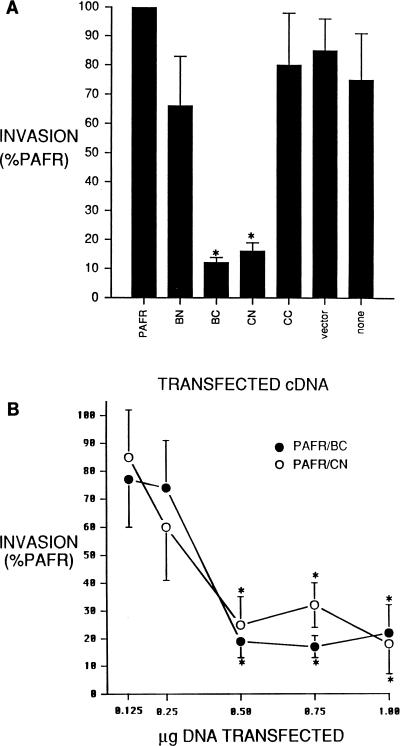FIG. 2.
Attenuation of Salmonella invasion by transfection of cDNAs encoding PAFR-invasion protein chimeras. (A) Effect of transfecting PAFR-invasion protein fusions on the invasion of S. typhimurium SL1344. BHK cells were transfected with insertless pCR3 vector (vector) or pCR3 containing a cDNA encoding the PAFR, PAFR/BN (BN), PAFR/BC (BC), PAFR/CN (CN), or PAFR/CC (CC). Invasion was also assessed in untransfected BHK cells (none). Cells were transfected, invasion assays were performed, and results were analyzed as described in Materials and Methods. Data represent the mean ± standard error of the mean from three separate transfections assayed simultaneously and repeated at least twice with similar results. Statistical significance was determined by analysis of variance with Scheffe’s F test for multiple comparisons. ∗, P < 0.05 versus PAFR transfectants. (B) Effects of transfecting increasing amounts of cDNAs encoding PAFR/BC or PAFR/CN. Total plasmid DNA was maintained at 1 μg/well by the addition of insertless pCR3 vector. Cells were transfected, invasion assays were performed, and results were analyzed as described in Materials and Methods. Data presented are standardized based on invasion data obtained from cells transfected with an equal dose of the PAFR cDNA. Invasion data derived from PAFR transfectants was statistically indistinct at all transfection doses. Dose-response data represents the mean ± standard error of the mean from three separate transfections assayed simultaneously and repeated at least twice with similar results. Statistical significance was determined by Student’s paired t test. ∗, P < 0.05 versus result from an equal dose of PAFR cDNA.

